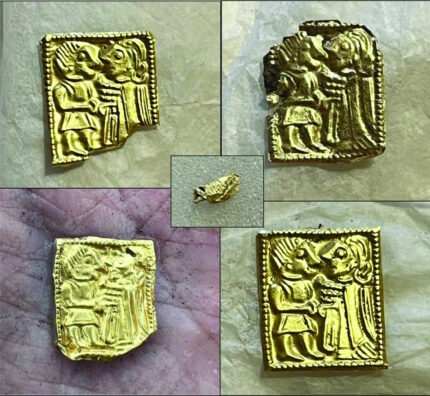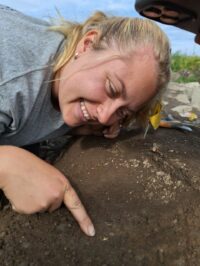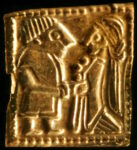 Norwegian archaeologists have unearthed five paper-thin stamped gold squares in Vingrom outside Lillehammer. The pieces are tiny, about the size of a fingernail, and as thin as paper or aluminum foil. They are typically stamped with figures of men and women in elegant clothes standing facing each other. They date to Norway’s Merovingian period, the era from 550 A.D. to the dawn of the Viking age in 793 A.D.
Norwegian archaeologists have unearthed five paper-thin stamped gold squares in Vingrom outside Lillehammer. The pieces are tiny, about the size of a fingernail, and as thin as paper or aluminum foil. They are typically stamped with figures of men and women in elegant clothes standing facing each other. They date to Norway’s Merovingian period, the era from 550 A.D. to the dawn of the Viking age in 793 A.D.
Despite the fact that the gold nuggets are so small, the motifs have a striking richness of detail. Usually the woman is dressed in a side dress, sometimes with a tow and a cape, and the man has a shorter skirt so that the feet are visible. He can also wear a cape, and both can wear jewelry, different hairstyles and hold different things like drinking cups, wands or rings in the hands or have hands to point to different gestures. They are actually so detailed and varied that they are the source of studies of the time’s costume and iconographic studies. […]
Most interpretations of gold guys mean that they have had a mythical or ritual meaning. And it is suggested that the gold nuggets with couple motifs reflect the hierogamy myth, the holy wedding between the habit god Frøy and the jotun daughter Gerd, or that they may have been used as an offering when celebrating a wedding or in fertility rituals. They can also be interpreted ideologically as representing the mythical ancestors or the descendants of chiefs and first families, and may then have served as an authentication of the ruling families’ power-political demands and ruling role.
 Excavations at the site along the E6 highway began this summer in advance of road expansion. Previous small-scale excavations in the area unearthed 30 gold squares that archaeologists believe were connected to a “god’s court,” an ancient place of worship that was discovered there in 1993. The building was small — no more than 50 feet long at a time when residential homes were usually between 65 and 100 feet long. Archaeologists believe it was used purely for ritual purposes rather than feasting or habitation. Perhaps only a select elite of society were allowed inside.
Excavations at the site along the E6 highway began this summer in advance of road expansion. Previous small-scale excavations in the area unearthed 30 gold squares that archaeologists believe were connected to a “god’s court,” an ancient place of worship that was discovered there in 1993. The building was small — no more than 50 feet long at a time when residential homes were usually between 65 and 100 feet long. Archaeologists believe it was used purely for ritual purposes rather than feasting or habitation. Perhaps only a select elite of society were allowed inside.
There are only about 10 such temple sites in Norway where the gold squares have been found, and the 30 found here were by far the largest single collection discovered at a god’s court. The team were therefore not expecting to find any more in the new excavation. They were elated to unearth five of them in the past two weeks.
 The newly-discovered gold squares are of particular significance because they were found in the precise locations of their deposition. Three of them were found where the wall of the temple once was. Two were found in postholes. For the first time, archaeologists are now able to link the gold pieces directly to the construction of the building. They were placed in the foundations before the walls were built.
The newly-discovered gold squares are of particular significance because they were found in the precise locations of their deposition. Three of them were found where the wall of the temple once was. Two were found in postholes. For the first time, archaeologists are now able to link the gold pieces directly to the construction of the building. They were placed in the foundations before the walls were built.
It’s not known what purpose the little gold people served, but one of the hypotheses is that they were given to the temple by worshippers as a kind of price of admission. The five pieces found under the walls and postholes could not have been accessible to people seeking admission to the building, so their discovery points to the squares having been a sacrifice or a ritual of protection before construction.
 The excavation is ongoing and over the fall and winter, the remains of the building will be radiocarbon dated. It should be possible to establish when the house of the gods was built and perhaps even how long it stood. The postholes indicate the building was in place for hundreds of years with the roof and supports replaced when they rotted.
The excavation is ongoing and over the fall and winter, the remains of the building will be radiocarbon dated. It should be possible to establish when the house of the gods was built and perhaps even how long it stood. The postholes indicate the building was in place for hundreds of years with the roof and supports replaced when they rotted.